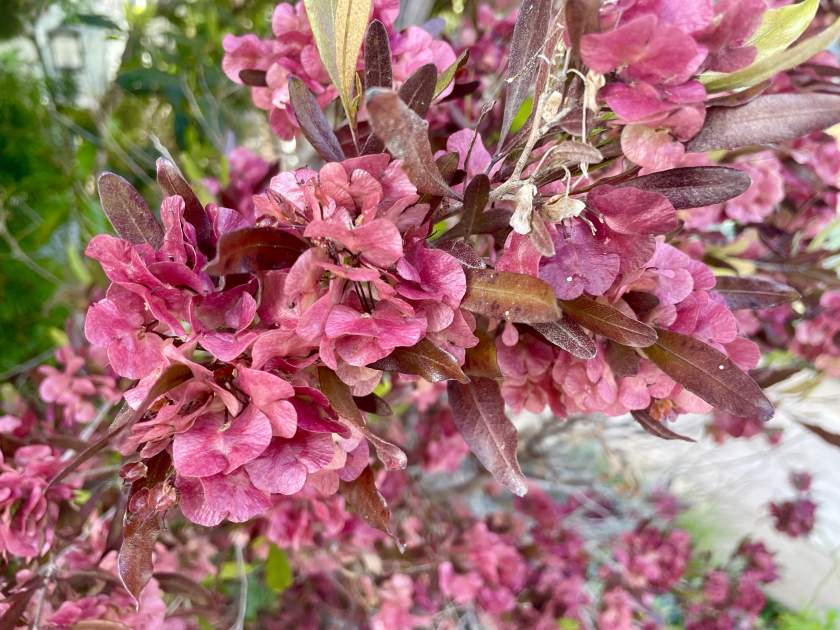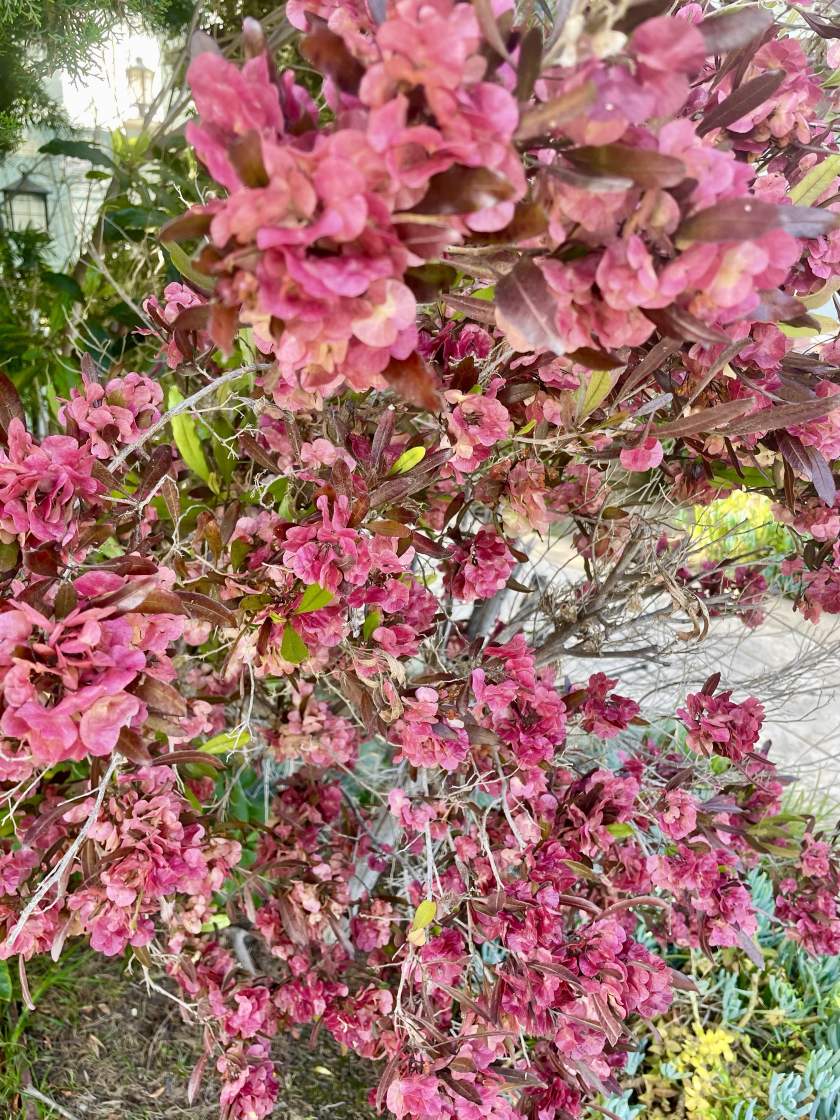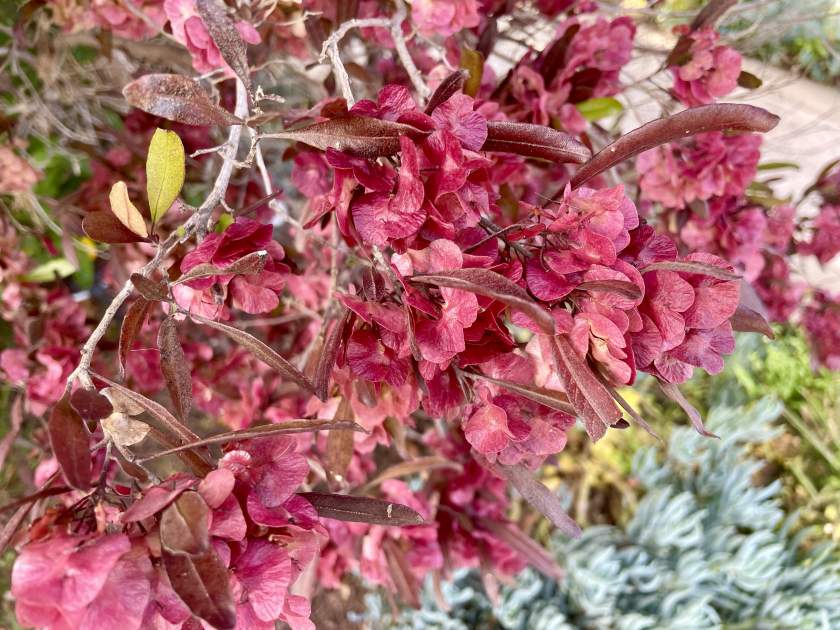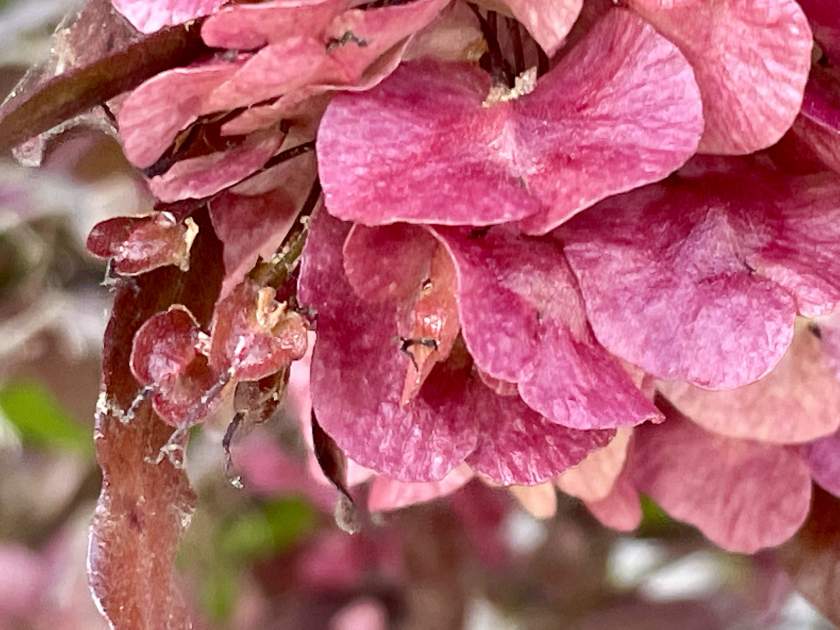Dodonaea viscosa ‘Purpurea’ – Purple-leafed Hop-bush
Dodonaea viscosa ‘Purpurea’, commonly known as Purple-leafed Hop-bush, Sticky Hop-bush, Switch Sorrel, Varnish Leaf, or Casol is a rapid-growing, evergreen shrub that can reach a height of 12 to 16 feet (3.6 to 4.8 meters) and a similar width. It is a color variant of the species Dodonaea viscosa, which has a wide cosmopolitan distribution. While the species is native to the southwest United States and northern Mexico, varieties and subspecies can be found throughout the tropics and sub-tropics, including Hawaii, New Zealand, and all Australian states and territories, and belongs to the family Sapindaceae.
The ‘Purpurea’ selection was discovered in the early 1890s by Mrs. Thomas Wilkins, a gardener who found it growing along the Wairau River near Marlborough in the South Island of New Zealand. Mrs. Wilkins collected seeds from the plant and grew them in her garden until a nurseryman in Christchurch obtained the seeds and introduced them into the New Zealand nursery trade, where it was known as Purple Ake Ake.
Characteristics and Description:
The Purple-leafed Hop-bush is characterized by narrow, bronzy-green leaves that can grow up to 4 inches (10 centimeters) in length. As cooler weather arrives, the leaves turn purple, adding a vibrant touch to the landscape. This evergreen shrub tolerates some shade, but its color is more pronounced when grown in full sun. Tiny green flowers appear in clusters during mid-summer, followed by brown maple-like seed capsules in late summer.
Female plants bear pendant fruits that resemble small Chinese lanterns, starting off light green and fading to pink or burgundy. The three-parted seed pods contain several small rounded black seeds. The overall appearance of the plant is highly ornamental, especially when the purple-leaved cultivars display their foliage in winter.
Flowering Season and Fragrance: Dodonaea viscosa ‘Purpurea’ produces small flowers, with the predominant sepals becoming noticeable in winter. The pinkish-colored fruits emerge in early spring, adding an extra element of visual interest to the plant. However, this species is not known for its fragrance or aroma.
Cultivation Dodonaea viscosa ‘Purpurea’:
Sunlight: The Purple-leafed Hop-bush thrives in full sun and is relatively intolerant to shade. It should be grown in an area that receives at least six hours of direct sunlight per day to promote optimal growth and foliage coloration.
Watering: While this shrub is drought-tolerant once established, it benefits from occasional deep watering, especially during prolonged dry periods. The watering frequency may vary depending on the desired size of the plant. Providing more water results in larger growth, potentially reaching a tree-like form. Conversely, withholding water will keep the plant smaller and more rounded. However, it is crucial to ensure that the soil does not become chronically wet, as the Purple-leafed Hop-bush requires well-draining soil.
Soil: Purple-leafed Hop-bush is tolerant of various soil textures but requires fast-draining soil to prevent waterlogging. It can adapt to dry sandy or rocky soils, as well as tolerate salt spray and windy conditions. Ideally, the soil should be well-drained to avoid waterlogged conditions that can be detrimental to the plant’s health.
Pests and Diseases: Dodonaea viscosa ‘Purpurea’ is generally pest and disease-free. However, it may be susceptible to Texas root rot if planted in poorly drained soil that becomes wet and warm, particularly during August and September. It is important to ensure good soil drainage to mitigate the risk of this disease.
Pruning:
Minimal pruning is required for the Purple-leafed Hop-bush. Routine pruning is not necessary, but it is advisable to remove any diseased, damaged, congested, or crossing shoots to maintain the plant’s overall health and appearance. Pruning for structural purposes can be carried out during fall and winter. The shrub also tolerates shearing if desired, even during the growing season.
Propagation: Dodonaea viscosa ‘Purpurea’ can be propagated through seed or softwood cuttings. To propagate from seed, collect mature seeds and sow them in well-draining soil. Softwood cuttings can be taken and treated with a rooting hormone containing 2,500 ppm IBA (indole-3-butyric acid) for successful rooting. Another propagation method is air layering, which involves encouraging roots to develop on a stem while it is still attached to the parent plant.
By following these cultivation guidelines, Dodonaea viscosa ‘Purpurea’ can thrive as a specimen or accent plant, create attractive wall-side borders, serve as hedges in Mediterranean gardens, or enhance coastal landscapes. With its drought tolerance and minimal maintenance requirements, this shrub offers a resilient and visually appealing addition to a variety of garden settings.







